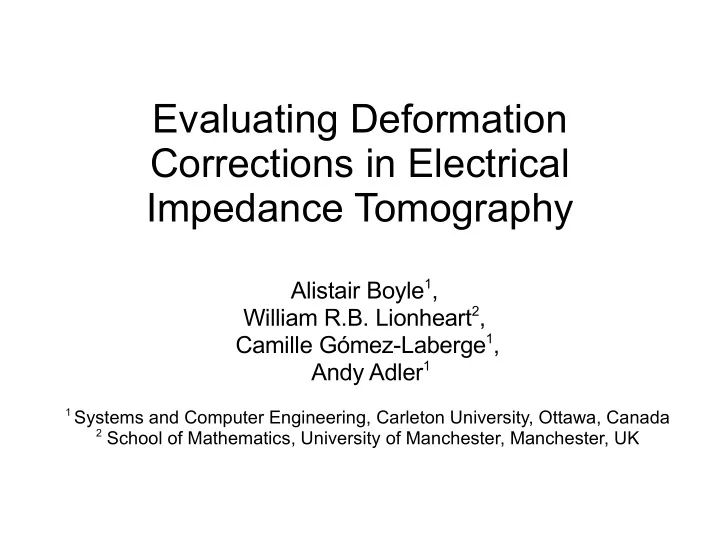

Evaluating Deformation Corrections in Electrical Impedance Tomography Alistair Boyle 1 , William R.B. Lionheart 2 , Camille Gómez-Laberge 1 , Andy Adler 1 1 Systems and Computer Engineering, Carleton University, Ottawa, Canada 2 School of Mathematics, University of Manchester, Manchester, UK
The Boundary Movement Problem ● Long suspected: errors in the knowledge of the boundary shape are an important factor in the inaccuracy of reconstruction. Corrected Uncorrected
Introduction: Chest EIT ● Boundary shape changes with breathing, desirable to correct the boundary shape using the EIT data so that a consistent isotropic conductivity can be fitted to the data. ● Should result in a distorted image due to the anisotropic nature of chest muscle, yet still preserve useful features of the lungs.
Introduction: Isotropy ● Boundary deformations do not preserve assumed isotropy of the domain. ● Thus, (for the isotropic case) data contains information about conductivity & Corrected Uncorrected boundary deformation.
Introduction: Previous Work ● Previous work to address shape changes in EIT has shown that: – theoretically, for an infinite number of electrodes, non-conformal changes in boundary shapes and electrode locations can be uniquely determined (Lionheart,1998); – in some cases, conductivity and shape changes can be recovered using a combined image reconstruction model of both conductivity and shape changes (Soleimani et al, 2006).
However ● Not all deformations lead to these anisotropic conductivities. ● The exception is exactly the distortions that are conformal maps. ● In 2-D, an infinite number of conformal maps.
Conformal Vector Field (in two dimensions) ● Also known as: – infinitesimal conformal motion, – conformal Killing field. ● Preserves the angle between vectors. z -> z + 0.01z 2 z -> 0.99x + i1.01y Conformal Non-Conformal
Simulation source Non-Conformal Conformal Combined without correction with correction
Phantom ● Plastic pan ● Deformable rubber gasket ● Saline solution ● 16 stainless- steel electrodes
2-D Experimental Deformations 2 points 3 points
Experimental Reconstruction No Deformation
Experimental Reconstruction 2 & 3 points, Without Deformation Correction
Experimental Reconstruction 2 points 3 points
Conclusion & Discussion ● Conformal and non-conformal vector fields as applied to EIT. ● Reconstruction of non-conformal electrode movement from conductivity change: simulation and experimental results show reduced artifacts.
Conclusion & Discussion ● One limitation is assumption of isotropy. – Further investigation with respect to known anisotropic domains (muscle tissue & flowing blood) would be interesting. ● Linear approximation of forward problem used, – holds out the hope that, with the correction of the boundary shape and electrode positions, using the EIT data will be sufficient for non-linear and accurate absolute EIT reconstruction of clinical data.
Thank you. Questions? Acknowledgement: This work was supported by a grant from NSERC Canada.
Recommend
More recommend